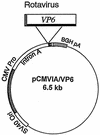Protective immunity induced by oral immunization with a rotavirus DNA vaccine encapsulated in microparticles
- PMID: 9621034
- PMCID: PMC110376
- DOI: 10.1128/JVI.72.7.5757-5761.1998
Protective immunity induced by oral immunization with a rotavirus DNA vaccine encapsulated in microparticles
Abstract
DNA vaccines are usually given by intramuscular injection or by gene gun delivery of DNA-coated particles into the epidermis. Induction of mucosal immunity by targeting DNA vaccines to mucosal surfaces may offer advantages, and an oral vaccine could be effective for controlling infections of the gut mucosa. In a murine model, we obtained protective immune responses after oral immunization with a rotavirus VP6 DNA vaccine encapsulated in poly(lactide-coglycolide) (PLG) microparticles. One dose of vaccine given to BALB/c mice elicited both rotavirus-specific serum antibodies and intestinal immunoglobulin A (IgA). After challenge at 12 weeks postimmunization with homologous rotavirus, fecal rotavirus antigen was significantly reduced compared with controls. Earlier and higher fecal rotavirus-specific IgA responses were noted during the peak period of viral shedding, suggesting that protection was due to specific mucosal immune responses. The results that we obtained with PLG-encapsulated rotavirus VP6 DNA are the first to demonstrate protection against an infectious agent elicited after oral administration of a DNA vaccine.
Figures





Similar articles
-
Immune responses and protection obtained by oral immunization with rotavirus VP4 and VP7 DNA vaccines encapsulated in microparticles.Virology. 1999 Jun 20;259(1):148-53. doi: 10.1006/viro.1999.9751. Virology. 1999. PMID: 10364499
-
Immune responses and protection obtained with rotavirus VP6 DNA vaccines given by intramuscular injection.Vaccine. 2001 Apr 30;19(23-24):3285-91. doi: 10.1016/s0264-410x(00)00543-0. Vaccine. 2001. PMID: 11312027
-
Protective immunity induced by rotavirus DNA vaccines.Vaccine. 1997 Jun;15(8):899-902. doi: 10.1016/s0264-410x(96)00272-1. Vaccine. 1997. PMID: 9234543
-
Nasal immunization of mice with a rotavirus DNA vaccine that induces protective intestinal IgA antibodies.Vaccine. 2004 Dec 9;23(4):489-98. doi: 10.1016/j.vaccine.2004.06.018. Vaccine. 2004. PMID: 15530697
-
Particle-bombardment-mediated DNA vaccination with rotavirus VP4 or VP7 induces high levels of serum rotavirus IgG but fails to protect mice against challenge.Virology. 1998 Oct 10;250(1):230-40. doi: 10.1006/viro.1998.9370. Virology. 1998. PMID: 9770437
Cited by
-
Oral Non-Viral Gene Delivery for Applications in DNA Vaccination and Gene Therapy.Curr Opin Biomed Eng. 2018 Sep;7:51-57. doi: 10.1016/j.cobme.2018.09.003. Epub 2018 Sep 26. Curr Opin Biomed Eng. 2018. PMID: 31011691 Free PMC article.
-
Chitosan-zein nano-in-microparticles capable of mediating in vivo transgene expression following oral delivery.J Control Release. 2017 Mar 10;249:150-161. doi: 10.1016/j.jconrel.2017.01.035. Epub 2017 Jan 31. J Control Release. 2017. PMID: 28153762 Free PMC article.
-
Biotechnological Interventions for the Production of Subunit Vaccines Against Group A Rotavirus.Cell Biochem Funct. 2024 Dec;42(8):e70031. doi: 10.1002/cbf.70031. Cell Biochem Funct. 2024. PMID: 39707603 Free PMC article. Review.
-
Unravelling aggregation propensity of rotavirus A VP6 expressed as E. coli inclusion bodies through in silico prediction.Sci Rep. 2024 Sep 13;14(1):21464. doi: 10.1038/s41598-024-69896-1. Sci Rep. 2024. PMID: 39271700 Free PMC article.
-
Trivalent combination vaccine induces broad heterologous immune responses to norovirus and rotavirus in mice.PLoS One. 2013 Jul 26;8(7):e70409. doi: 10.1371/journal.pone.0070409. Print 2013. PLoS One. 2013. PMID: 23922988 Free PMC article.
References
-
- Bishop R F. Development of candidate rotavirus vaccines. Vaccine. 1993;11:247–254. - PubMed
-
- Burns J W, Pajouh M S, Krishnaney A A, Greenberg H B. Protective effect of rotavirus VP6-specific IgA monoclonal antibodies that lack neutralizing activity. Science. 1996;272:104–107. - PubMed
-
- Chen S C, Fynan E F, Robinson H L, Lu S, Greenberg H B, Santoro J C, Herrmann J E. Protective immunity induced by rotavirus DNA vaccines. Vaccine. 1997;15:899–902. - PubMed
Publication types
MeSH terms
Substances
Grants and funding
LinkOut - more resources
Full Text Sources
Other Literature Sources
Miscellaneous

